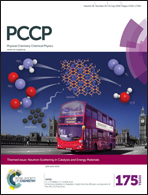Methanol diffusion in zeolite HY: a combined quasielastic neutron scattering and molecular dynamics simulation study
Abstract
The diffusion of methanol in zeolite HY is studied using tandem quasielastic neutron scattering (QENS) experiments and molecular dynamics (MD) simulations at 300–400 K. The experimental diffusion coefficients were measured in the range 2–5 × 10−10 m2 s−1 and simulated diffusion coefficients calculated in the range of 1.6–3.2 × 10−9 m2 s−1. Activation energies were measured as 8.8 and 6.9 kJ mol−1 using QENS and MD respectively. Differences may be attributed predominantly to the experimental use of a dealuminated HY sample, containing significant defects such as strongly adsorbing silanol nests, compared to a perfect simulated crystal containing only evenly distributed Brønsted acid sites. Experimental and simulated diffusivities measured in this study are lower than those obtained from those previously calculated in siliceous faujasite, due to methanol H-bonding to Brønsted acid sites as observed in the MD simulations. However, both experimental and simulated diffusivities were significantly higher than those obtained in NaX, due to the higher concentration of extraframework cations present in the previously studied structures.

- This article is part of the themed collection: Neutron Scattering in Catalysis and Energy Materials


 Please wait while we load your content...
Please wait while we load your content...